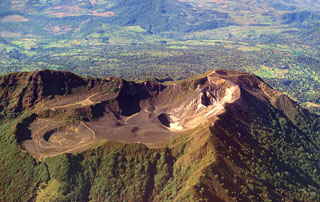Report on Turrialba (Costa Rica) — September 2022
Bulletin of the Global Volcanism Network, vol. 47, no. 9 (September 2022)
Managing Editor: Edward Venzke.
Research and preparation by Paul Berger.
Turrialba (Costa Rica) Small phreatic eruption on 17 July 2022
Please cite this report as:
Global Volcanism Program, 2022. Report on Turrialba (Costa Rica) (Venzke, E., ed.). Bulletin of the Global Volcanism Network, 47:9. Smithsonian Institution.
Turrialba
Costa Rica
10.025°N, 83.767°W; summit elev. 3340 m
All times are local (unless otherwise noted)
Activity began to subside at Turrialba after 2019, following a period of weak ash explosions and emissions, allowing for the reappearance of a hydrothermal system. Thereafter, occasional weak explosions at this Costa Rican stratovolcano were thought to be phreatic (steam-driven), with associated minor passive ash emissions (BGVN 46:09, 47:04). The following report summarizes activity from March-August 2022 and is based primarily on information from periodic reports published by the Observatorio Vulcanologico Sismologica de Costa Rica-Universidad Nacional (OVSICORI-UNA) and satellite data.
Overall activity was at a low level during this reporting period. Occasional small rumblings were recorded, some associated with minor ash emissions. Seismicity remained low, eventually returning to the pre-June 2021 level, and geodetic monitoring showed that the Irazú-Turrialba massif continued to subside and contract, especially around the active Turrialba crater.
In early April 2022 an inspection of the bottom of the West Crater (or Bat Crater) with a drone revealed some fumaroles, mainly in the eastern sector, releasing steam and sulfur gases. The fumaroles registered temperatures of at least 113°C according to remote measurement with an infrared thermograph.
According to OVSICORI-UNA, at 0749 on 17 July a brief phreatic eruption was recorded. An ash emission rose less than 500 m above the crater and drifted SW, with minor ashfall in Irazú Volcano National Park. This was the only eruption during the reporting period, and the first since 27 February 2022. Seismic activity continued to decrease.
A sulfur dioxide plume was detected originating from Turrialba on 30 August, using the TROPOMI instrument on the Sentinel-5P satellite. According to OVSICORI-UNA, the plume contained 108 tons of SO2.
Geological Summary. Turrialba, the easternmost of Costa Rica's Holocene volcanoes, is a large vegetated basaltic-to-dacitic stratovolcano located across a broad saddle NE of Irazú volcano overlooking the city of Cartago. The massive edifice covers an area of 500 km2. Three well-defined craters occur at the upper SW end of a broad 800 x 2200 m summit depression that is breached to the NE. Most activity originated from the summit vent complex, but two pyroclastic cones are located on the SW flank. Five major explosive eruptions have occurred during the past 3500 years. A series of explosive eruptions during the 19th century were sometimes accompanied by pyroclastic flows. Fumarolic activity continues at the central and SW summit craters.
Information Contacts: Observatorio Vulcanologico Sismologica de Costa Rica-Universidad Nacional (OVSICORI-UNA), Apartado 86-3000, Heredia, Costa Rica (URL: http://www.ovsicori.una.ac.cr/); NASA Global Sulfur Dioxide Monitoring Page, Atmospheric Chemistry and Dynamics Laboratory, NASA Goddard Space Flight Center (NASA/GSFC), 8800 Greenbelt Road, Goddard MD, USA (URL: https://so2.gsfc.nasa.gov/).

